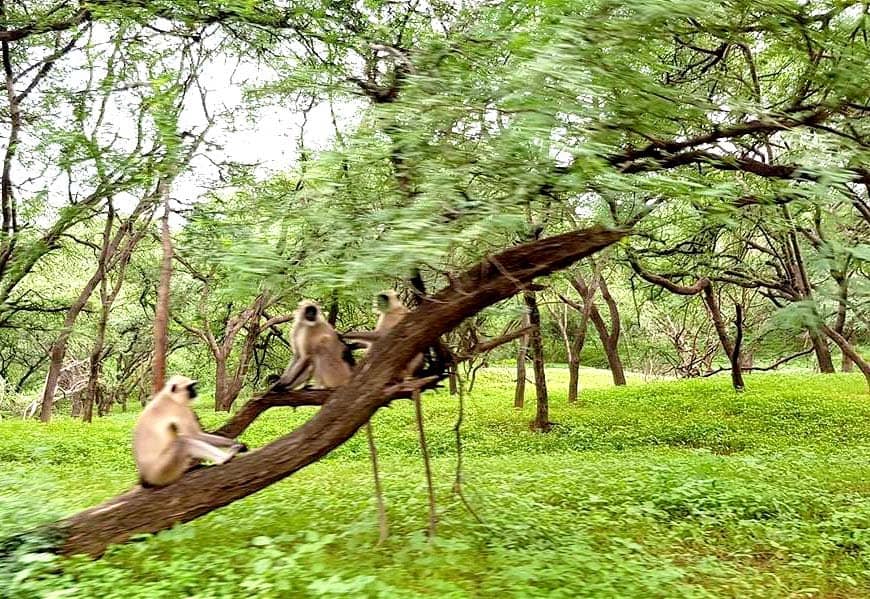Rajasthan’s Leopard Safari Parks

Introduction
Rajasthan, located in the northwestern region of India, is known for its rich cultural heritage and diverse wildlife. One of the most popular wildlife attractions in the state is the leopard safari parks. These parks offer visitors the opportunity to see these majestic big cats in their natural habitat and learn more about their behavior and conservation.
there are so many places to see tigers most famous are Jhalana leopard Safari
Sariska Tiger Reserve,
located in Alwar district, is one of the most popular leopard safari parks in Rajasthan. The reserve is spread over an area of 866 square kilometers and is home to a wide variety of wildlife including leopards, tigers, and several species of birds. Visitors can take a jeep safari or a nature walk to spot the leopards and other animals in the park. The park also has several watchtowers, which offer a panoramic view of the reserve and a chance to spot leopards and other animals from a distance.
Ranthambore National Park,
situated in Sawai Madhopur district, is another popular leopard safari park in Rajasthan. The park is known for its large population of leopards, as well as tigers, crocodiles, and a variety of other wildlife. Visitors can take a jeep safari or a nature walk to see the leopards and other animals in the park. The park also has several watchtowers, which offer a panoramic view of the reserve and a chance to spot leopards and other animals from a distance.
Mukundara Hills Tiger Reserve,
located in Kota district, is another excellent place to spot leopards in Rajasthan. The reserve is spread over an area of 975 square kilometers and is home to a healthy population of leopards, as well as tigers, sloth bears, and other animals. Visitors can take a jeep safari or a nature walk to see the leopards and other animals in the park. The park also has several watchtowers, which offer a panoramic view of the reserve and a chance to spot leopards and other animals from a distance.
Keladevi National Park
is located in the Chambal Valley and is one of the best places to spot leopards, along with other wildlife like the Chinkara, the Indian Gazelle. The park is spread over an area of 699 sqkm. The park also has several watchtowers, which offer a panoramic view of the reserve and a chance to spot leopards and other animals from a distance.
Amagarh Safari Park
is India’s alternate Leopard Reserve located near Galta Ji( An Hindu passage spot) in Jaipur city of Rajasthan state, India. the oldest mountain range in India, the Aravalli Range, Amagarh became a leopard reserve. The reserve is spread over an area of,524 hectares, with immense foliage and fauna present in the park.
The Amagarh Leopard Conservation Reserve presently has a population of 15 – 20 healthy Leopards, other than leopards there are other carnivorous & herbivorous species.
These are just a few of the many leopard safari parks in Rajasthan, each offering its own unique experience. Visitors should keep in mind that the best time to visit these parks is from October to June when the weather is more pleasant and the chances of spotting leopards and other animals are higher. It’s always best to check for updates and current rules & regulations before planning a visit to any of these parks.
In addition to these safari parks, Rajasthan has other wildlife sanctuaries like the Darrah wildlife sanctuary, Bassi wildlife sanctuary, Sita Mata wildlife sanctuary and Kumbhalgarh wildlife sanctuary. These sanctuaries are known for their diverse wildlife and are home to several species of animals, including leopards. Visitors can take a nature walk or a jeep safari to spot the leopards and other animals in these sanctuaries.
Conservation of leopards in Rajasthan is crucial as they are facing threat from human activities such as habitat loss, poaching, and human-wildlife conflict. Rajasthan forest department has been working towards conserving the leopard population by implementing various measures such as conservation breeding programs, anti-poaching measures, and community-based conservation initiatives. They also work closely with local communities to educate them about the importance of leopard conservation and to reduce human-wildlife conflict. Overall, Rajasthan offers visitors the opportunity to see leopards and other wildlife in their natural habitat, while also promoting conservation efforts to protect these animals for future generations. Visitors should keep in mind that it is important to follow the rules and regulations of the parks and sanctuaries, and to respect the animals and their habitat.
Being a hidden jewel of Rajasthan, Jawai offers a perfect terrain for syncretic wildlife to thrive. The emerald region, harmony prevails for humans and creatures alike in this wonderland. Leopards in the Jawai Safari lives in natural caves so well. It’s really an amazing fact that Leopards can be observed in the rugged or uneven terrains of Jawai Sanctuary. Experience the leopard safari in Jawai which offers you to enjoy animal sighting, crocodiles and birds watching.
Checkout more content






